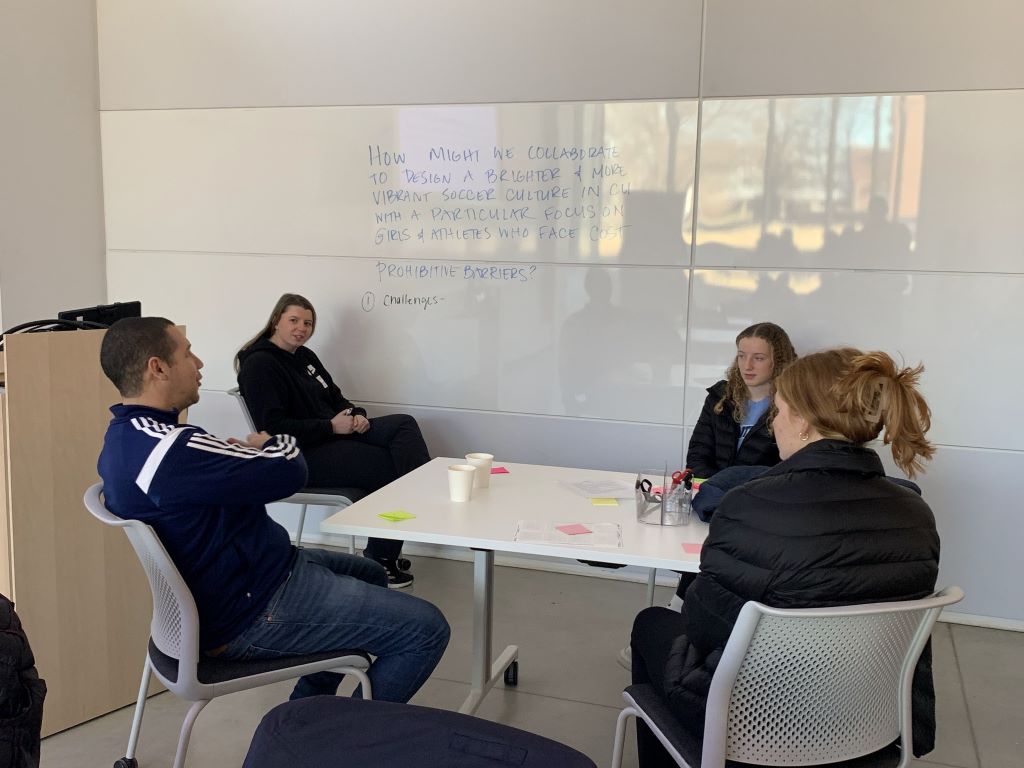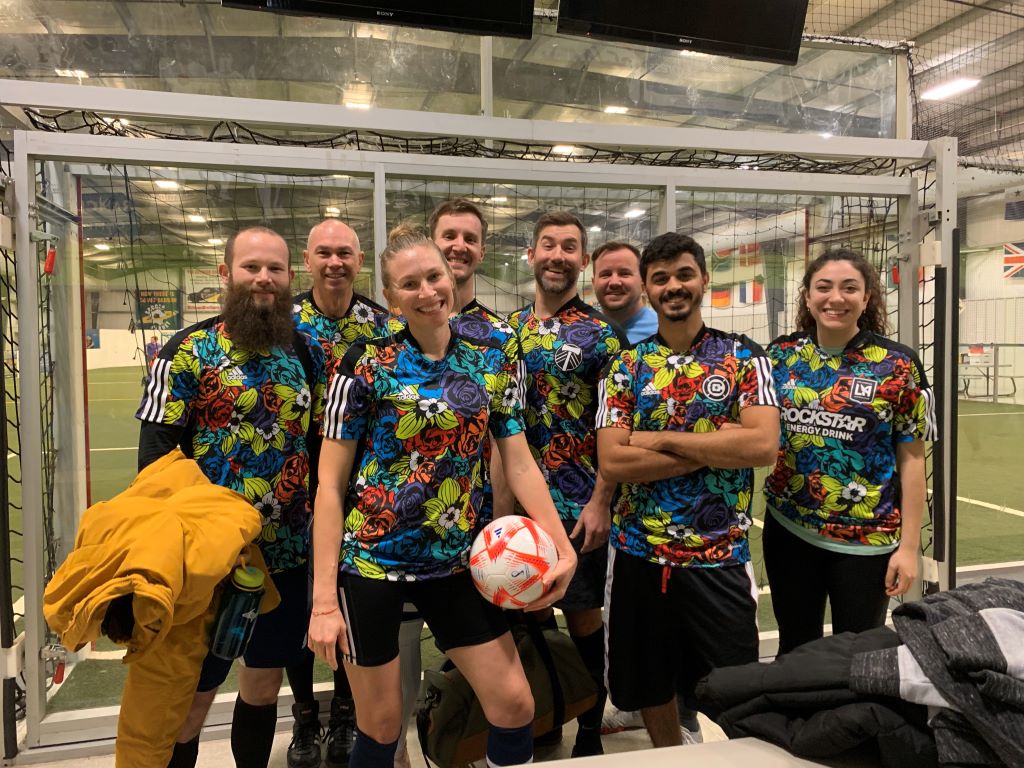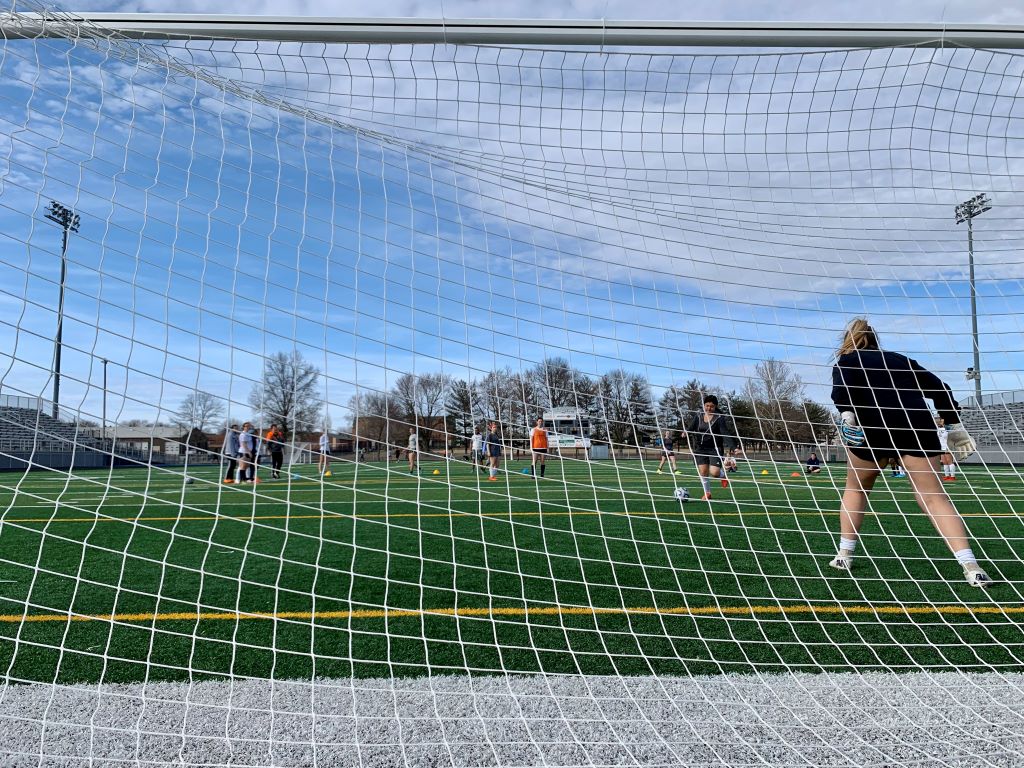I caught Lindsay Aikman during a small window of time she had between coaching her Champaign Centennial JV girls soccer team, watching her own child play soccer in a nearby town, and playing in an adult league game at Soccer Planet. One could say she is rather immersed in soccer culture in this area. She also doesn’t let any grass grow under her feet. In addition to coaching and parenting and playing soccer, you’ll find her teaching English and Social Justice at Centennial or pitching in at Bread Company — the family business. So, why not take on one more thing? The thing about Aikman, is that when she sees a problem or a need, she starts asking questions and building solutions. The current problem she sees is a disconnect between the sport of soccer and girls in the community.

The solution building began with a “soccer summit” that brought together area coaches, players, families, and other stakeholders in the sport, including Illinois Futbol Club Director Lyle Barreiro and U of I Women’s coach Janet Rayfield to form the C-U Soccer Consortium. Now, this Thursday, girls teams from Centennial, Central, Urbana, and St. Thomas More will gather to compete against each other at Demirjian Park. In our brief conversation, Aikman offered her perspective on girls and soccer.
Responses have been edited for length and clarity.
Smile Politely: What is the soccer landscape like for girls in C-U?
Lindsay Aikman: I’m speaking anecdotally from what I see as a mom and as a JV coach. What I see is a ton of girls on the field in kindergarten and first grade, and even younger than that, and then they disappear. There’s one girl on a [coed] team, or two girls on a team. Then they all turn out for tryouts in ninth grade. In huge numbers. They want to be a part of soccer culture. They want the skills, but they’ve missed all these developmental years. There are times when girls have tried to sign up for park district teams, but there’s no team for them to sign up for. I’m being told that there’s not enough interest. Now that I’m coaching, I see that’s simply not true. They are interested. I don’t know what’s happening. That’s why I wanted to get all the soccer power players in one room, to try to problem solve ways that [soccer] programs could be more accessible and inviting, and incentivize girls to stick with them. The programs are willing.
SP: What are some thoughts and ideas that came out when you all gathered to talk about this?
Aikman: We partnered with the Siebel Center of Design and did a “design thinking challenge.” We only had time to get through the first part of the process, so I’m hoping we can reconvene and continue to dig deeper into why this is happening. Design thinking centers the human, or the user, and you innovate out from there. That’s why I wanted it to be the power players, and also the girls and their families to find out what is going on. It’s not happening with the boys, and it’s not happening in other communities. That’s why we’re getting beat by Bloomington and Peoria.
SP: And one of the outcomes of the summit is the event happening this week. Can you talk a little about what’s happening?
Aikman: I’m so excited. The event that’s happening this week is proof that we are resource rich and that the bridges want to be built. Coach Rayfield initiated a tour of Demarjdin Park and the facilities. At first we had the idea of doing this with just Centennial and one other school, but that’s not the mission of the event. We wanted as many girls to get the spotlight as possible. What I really hope is that team soccer shows up and shows out, and that young girls (and boys) can be part of the walkout, holding the hands of our varsity players and looking up at the lights and thinking “what will it take to get me here.” I hope our girls can have the experience of this vast gorgeous field, with U of I athletes on the sidelines running balls, listening to their name over the speakers, and thinking “this is what dreams are made of. This is what I want for myself and my younger siblings and cousins.”

SP: Getting a little more personal here, as a girl and now woman who plays soccer, how has the sport impacted your life?
Aikman: I think about this a lot. I’m 42, and I’m still playing. And I’m a Title IX baby. I don’t think our mothers had the same opportunities we did growing up. I was lucky that my suburb had a soccer program, but I feel like it was kind of hit or miss in the eighties. Soccer gave me so much. Exercise is so important for mental health. It’s so important for camaraderie and sportsmanship. I’m still good friends that I was captain with on my team. I see how much it’s done for me in my life. Coming up in soccer in the eighties and nineties we saw the women win gold — Brandy Chastain and Mia Hamm, we idolized them. We’ve seen the program fight for equity this whole time, and pave the way for female soccer players around the globe. It’s a moment, and it just doesn’t make sense that we don’t have access to [something] better for our girls in Champaign-Urbana. The soccer community is so excited about soccer. It’s such a small community, and close knit. We’re all friends, even when we find ourselves on opposite sides of the field. It’s about harnessing that momentum.
SP: What’s your ultimate goal? What do you hope to see? I know you have a young girl coming up in soccer as you work to address this.
Aikman: I want to dream it for her, but I also want to dream it for all of her friends that she has yet to make on the field. I would just love to walk through Dodds (Park) on a Saturday and see teams and teams of girls. That’s the dream right now. I’d love the event that’s happening on Thursday to recur. I would love for there to be a stronger bridge between Parkland and U of I and our youth programming. There’s room for bridges to be built.
SP: Anything else you want people to know?
Aikman: I want people to know how proud I am of the girls that are showing up, even though it’s a new sport for them. To tackle a new sport at age 14…it’s like learning a language for the first time, or picking up an instrument for the first time. It takes grit to stay on that field when you know what you want the skill to look like, but you can’t access it quite yet. I’m proud of them for lacing up their cleats, getting muddy, and participating in a beautiful sport. Because once you fall in love with it, you can stay in love with it the rest of your life. Women belong in sports conversations, and they belong on fields on courts, wherever.
Girls Soccer Night in C-U is Thursday, April 14th, at Demirjian Park. Urbana and Central JV teams will face off at 4 p.m., Centennial and St. Thomas More varsity teams play at 5:30 p.m., and Urbana and Central varsity teams play at 7 p.m. Admission is $5 for adults, and $3 for kids 12 and under.








